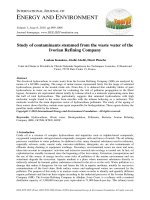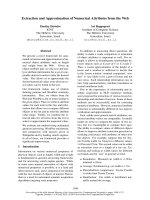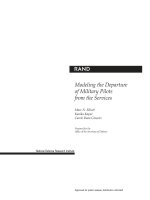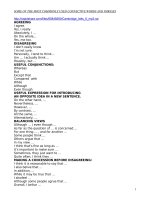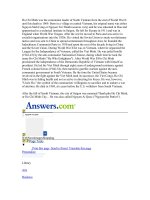Assessment of microbial load from the polayamide netting materials kept in soil, water and atmosphere
Bạn đang xem bản rút gọn của tài liệu. Xem và tải ngay bản đầy đủ của tài liệu tại đây (154.3 KB, 4 trang )
Int.J.Curr.Microbiol.App.Sci (2018) 7(9): 1437-1440
International Journal of Current Microbiology and Applied Sciences
ISSN: 2319-7706 Volume 7 Number 09 (2018)
Journal homepage:
Original Research Article
/>
Assessment of Microbial Load from the Polayamide Netting Materials
kept in Soil, Water and Atmosphere
Sandipan Mondal1*, Mosaraf Hossain1, Arnab Bandyopadhyay1,
Devika Pillai2 and B. Manojkumar3
1
Fishery Engineering & Technology, Kerala University of Fisheries and
Ocean Studies, Kerala, India
2
Department of Fish Pathology, Kerala University of Fisheries and Ocean Studies,
Kerala, India
3
Department of Pathology Payyanur Fisheries Station, Kerala, India
*Corresponding author
ABSTRACT
Keywords
Polyamide,
Monofilament,
Multifilament, Microbial
load
Article Info
Accepted:
10 August 2018
Available Online:
10 September 2018
Polyamides are the most commonly used polymers for routine applications as well as in
the fisheries sector for the construction of fishing gear due to its high resistancey. The
accumulation of polyamide after thrown in environment or the effect of ghost fishing is a
threat to environment as it causes pollution, creating an imbalance in the ecosystem, thus
proving to be hazardous. As polyamide is highly resistant to the environment, the natural
degradation of polyamide is too time consuming and at the same time the ways to degrade
polyamide have not been successful. The main objective of the present study is to assess
the microbial load of the polyamide netting materials exposed in soil, water and
atmosphere using standard microbial procedures.
Introduction
The use of polyamide materials have been
increased in food clothing, shelter,
transportation, construction, medical, and
recreation industries.
and degrade it encourages research and studies
in the field of biosynthetic and biodegradation
material. One of the waste that cannot be
destroyed is polyamide waste, which is a type
of a plastic waste.
Materials and Methods
They are most widely used worldwide as they
are having certain advantages like they are
strong, light-weighted, durable and having the
highest elastic recovery than any other
polymer. However, they are disadvantageous
as they are resistant to biodegradation, leading
to pollution, harmful to the natural
environment.
Increasing
environmental
pollution and waste that cannot be renewed
The test material comprised samples of: (i) PA
monofilament yarn of specification viz. of
diameter 0.23 mm diameter and (ii) PA
multifilament twine of specification, viz. 210
d × 1 × 2.
Samples were kept in three environmental
conditions i.e., water, atmosphere and soil.
1437
Int.J.Curr.Microbiol.App.Sci (2018) 7(9): 1437-1440
Sub-samples from the test material were
removed for the assessment of microbial load
after 8, 15, 30, 45, 60, 90 days of exposure.
The test exposure was done from February,
2018 to May, 2018.
from February to May 2018. The two ends of
the samples were tied to Polypropylene ropes
with a 2 cm gap in between and taking care
that there is no tension in the material and then
mounted on a frame of 1m x 0.7m.
Soil
Microbial load and colony morphology was
assessed after each sampling by taking Total
Plate Count and visual observation.
Assessment of total plate count (TPC) was
done as per the standard procedure given
below and colonies were serially numbered
based on their morphological characters such
as color, shape, transparency etc. 10 grams of
exposed sample was collected using a sterile
scissor and transferred into a sterile mortar.
Polyamide samples were buried in soil at 20
cm
depth
sewn
with
vinyl-coated
polypropylene (PP) rope 2 cm apart on a
frame. Samples were buried in the
experimental tank outside the Department of
Fishery Engineering & Technology, Kerala
University of Fisheries and Ocean Studies at a
latitude of 9°54'44.92"N and longitude of
76°19'2.67"E.
No. of bacteria/g = (No. of colonies per ml x
reciprocal of dilution x 100) / weight of the
sample
Marine condition
Experiment was conducted by keeping the
samples in a glass aquarium of the size
180 cm × 80 cm × 80 cm; length, width, height
having a total capacity of 1000 L. Seawater
was collected from Chellanam, Kochi (Kerala)
in plastic drums. Samples were sewn into a
rope made with plastic to prevent eventually
forming fragments from falling apart. The
rope was with non-biodegradable vinyl-coated
polypropylene having a diameter of about
280 mm.
The rope along with the nylon samples were
suspended in the aquarium, the distance
between the samples was approximately 5 cm.
To avoid large temperature fluctuations the
tank was kept inside lab and covered with a
sheet.
Results and Discussion
Colony morphology and microbial load during
each sampling time of each sample was
observed. Microbial load of the sample during
each sampling time is shown in Table 1. In
soil the microbial load after 90th day for mono
and multifilament were 2.3 x 10^5 cfu/g and
1.7 x 10^6cfu/g respectively.
In water the loads were 2.1 x 10^7 cfu/g and
2.3 x 10^6cfu/g respectively. In atmosphere
for mono and multifilament samples upto3rd
and 2nd sampling, there were no colonies
found in petri plates. However, at the end of
90 the day microbial load on mono and
multifilament were 3.3 X 10^4 cfu/g and 3.9
X 10^4cfu/g.
Atmospheric condition
The samples were exposed to atmospheric
conditions on the roof top of the Department
of Fisheries Engineering Kerala University of
Fisheries and Ocean Studies (9°54'44.92"N
and 76°19'2.67"E) for a period of 3 months
Table 2 showed the morphological
characteristics of the colonies with color,
margin and shape. Among the all colonies,
yellow and pale yellow color colonies were
found from samples of all three environments
and were most abundant.
1438
Int.J.Curr.Microbiol.App.Sci (2018) 7(9): 1437-1440
Table.1 Microbial load of mono and multifilament samples in different environments
DAY
8
15
30
45
60
90
MONOFILAMENT SAMPLES
SOIL
WATER
ATMOSPHERE
(CFU/g)
(CFU/g)
(CFU/g)
3.1 x 10^4
3.5 x 10^5
No colony
3.7 x 10^4
1.7 x 10^6
No colony
4.2 x 10^4
2.2 x 10^6
No colony
4.6 x 10^4
2.3 x 10^6
2.8 x 10^4
2.0 x 10^5
8.7 x 10^6
3.1 x 10^4
2.3 x 10^5
2.1 x 10^7
3.3 x 10^4
MULTIFILAMENT SAMPLES
SOIL
WATER
ATMOSPHERE
(CFU/g)
(CFU/g)
(CFU/g)
4.0 x 10^4
2.5 x 10^5
No colony
2.5 x 10^5
2.8 x 10^5
No colony
3.0 x 10^5
3.0 x 10^5
3.4 x 10^4
3.3 x 10^5
1.6 x 10^6
3.5 x 10^4
1.3 x 10^6
1.7 x 10^6
3.6 x 10^4
1.7 x 10^6
2.3 x 10^6
3.9 x 10^4
Table.2 Assessment of microbial load of mono and multifilament samples in difference
conditions on agar medium
SOIL
WATER
Colony
no.
Color
Shape
Margin
Colony
no.
Color
Shape
Margin
Colony
ATMOSPHERE no.
Color
Shape
Margin
1
2
3
4
Yellow
Transparent
White
Green
Round
Circular
1
Round
Circular
2
Round
Circular
3
White
Pale yellow Creamish
white
Rod
Rod
Oval
Circular
Circular
Circular
1
2
5
6
Creamish
Red
Pale yellow
white
Irregular
Oval
Oval
Rod
Weavy
Circular Circular Cylindrical
4
5
6
yellow
Red
Orange
Round
Circular
Round
Circular
Oval
Circular
Yellow Pale yellow
Round
Irregular
Circular
Weavy
A gradual increase in the microbial load was
observed for both samples in all three
environments. At the end of the 90 days the
microbial load was maximum for the samples
kept in water for both mono and multifilament
and minimum for the samples kept in
atmosphere. Types of microbes found more in
the samples kept in soil and minimum was
found in the samples kept in atmosphere.
Acknowledgement
I wish to thank Director, Central Institute of
Fisheries
Technology,
Kochi;
Vice
Chancellor, Kerala University of Fisheries &
Ocean Studies, Kochi for the opportunity to
carry out the work.
1439
7
Int.J.Curr.Microbiol.App.Sci (2018) 7(9): 1437-1440
References
Asmita, K., Shubhamsingh, T. and Tejashree,
S., 2015. Isolation of plastic degrading
micro-organisms from soil samples
collected at various locations in
Mumbai, India. Int Res J EnvirSci, 4(3),
pp.77-85.
Gouda, M.K., Swellam, A.E. and Omar, S.H.,
2012. Biodegradation of synthetic
polyesters (BTA and PCL) with natural
flora in soil burial and pure cultures
under ambient temperature. Research
Journal of Environmental and Earth
Sciences, 4(3), pp.325-333.
Mahdiyah, D. and Mukti, B.H., 2013.
Isolation of Polyethylene Plastic
Degrading-Bacteria. Biosci. Inter, 2(3),
pp.29-32.
Singh, G., Singh, A.K. and Bhatt, K., 2016.
Biodegradation of polythenes by
bacteria isolated from soil. Int J Res
Dev Pharm L Sci, 5(2), pp.2056-2062.
Skariyachan, S., Patil, A.A., Shankar, A.,
Manjunath, M., Bachappanavar, N. and
Kiran, S., 2018. Enhanced polymer
degradation of polyethylene and
polypropylene by novel thermophilic
consortia of Brevibacillus sps. And
Aneurini bacillus sp. screened from
waste management landfills and sewage
treatment plants. Polymer Degradation
and Stability, 149, pp.52-68.
How to cite this article:
Sandipan Mondal, Mosaraf Hossain, Arnab Bandyopadhyay, Devika Pillai and Manojkumar,
B. 2018. Assessment of Microbial Load from the Polayamide Netting Materials Kept in Soil,
Water and Atmosphere. Int.J.Curr.Microbiol.App.Sci. 7(09): 1437-1440.
doi: />
1440
